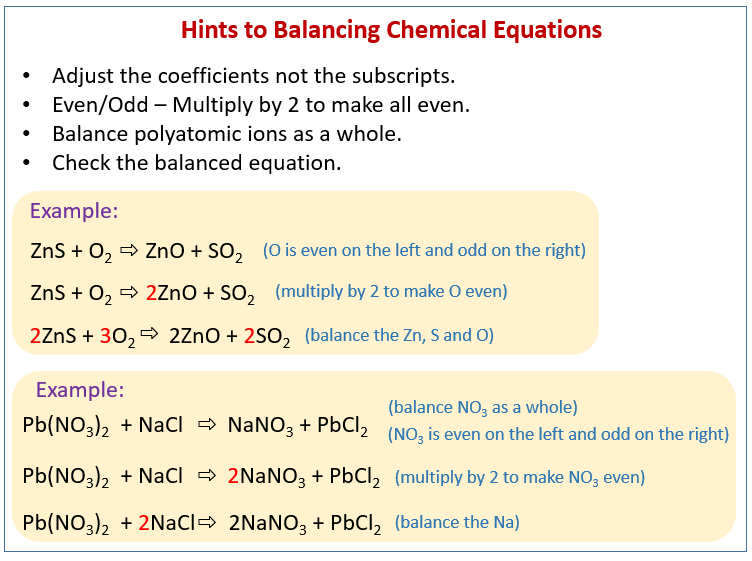How to balance chemical equations
Atoms can neither be destroyed nor created during a simple chemical reaction. Therefore, in a chemical reaction
The sum of atoms before reaction = the sum of atoms after reaction
General Rules for balancing chemical equations
The following figure gives some hints on how to balance chemical equations. Scroll down the page for more examples and solutions.

Balancing chemical equations may require some trial and error. There are some general rules that could be helpful, but they may not work all the time.
- Rule 1: Balancing chemical equations using the one’s and two’s technique
- Rule 2: Balancing chemical equations using the two’s and three’s technique
- Rule 3: Balancing chemical equations using the CHO technique
- Rule 4: Balancing chemical equations using the even technique
- Rule 5: Balancing chemical equations containing polyatomic ions
In this page, we will look at some examples of applying
Rule 3: Balancing chemical equations using the CHO technique.
If you are balancing equations that have carbon, hydrogen and oxygen atoms then balance the carbon atoms first, the hydrogen atoms second and the oxygen atoms last.
Example:
Balance the chemical equation
C5H12 + O2 → CO2 + H2O
Solution:
Step 1: Start with C. To balance the C put the coefficient of 5 for CO2
C5H12 + O2 → 5CO2 + H2O
Step 2: Then, balance the H by placing the coefficient of 6 for H2O
C5H12 + O2 → 5CO2 + 6H2O
Step 3: Lastly, balance the O by placing the coefficient of 8 for O2
C5H12 + 8O2 → 5CO2 + 6H2O
Step 4: Check that all the atoms balance and make sure that all coefficients are in the lowest-possible ratio.
The following videos show some examples of using the CHO method to balance chemical equations.
Try out our new and fun Fraction Concoction Game.
Add and subtract fractions to make exciting fraction concoctions following a recipe. There are four levels of difficulty: Easy, medium, hard and insane. Practice the basics of fraction addition and subtraction or challenge yourself with the insane level.

We welcome your feedback, comments and questions about this site or page. Please submit your feedback or enquiries via our Feedback page.